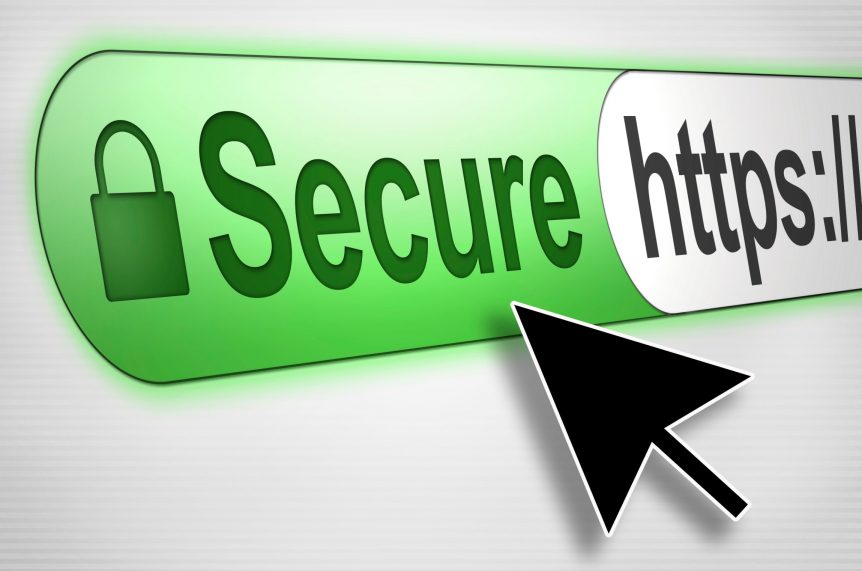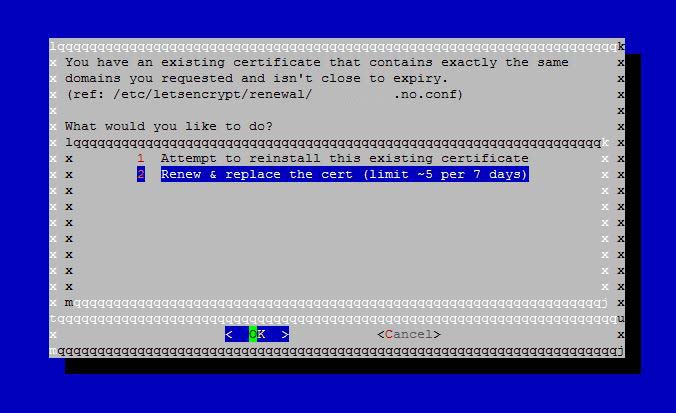Install the Let’s Encrypt client
$ git clone https://github.com/letsencrypt/letsencrypt
$ cd letsencrypt
I didn’t have git installed, so I just downloaded it from Github and added it under /opt/letsencrypt on the server.
So to the Centos 6 «fix»
You’ll need to run the client in Pyhon 2.7.
$ yum install centos-release-SCL
$ yum install python27
Your python version should still be 2.6.6.
$ python -V
Python 2.6.6
Run the client
$ scl enable python27 «/opt/letsencrypt/letsencrypt-auto –apache -d mydomain.no»
While installing you will get a config screen where you enter your mail and select the virtual host. As my Centos 6 apache does not have virtual host files like Centos7, the letsencrypt software only found default ssl.conf under /etc/httpd/conf.d/.
As I had my virtual hosts under /etc/httpd/conf/httpd.conf, i removed the created virtual host under ssl.conf and added the necessary info in my /etc/httpd/conf/httpd.conf, like this:
<VirtualHost *:443> SSLEngine on SSLProtocol all -SSLv2 SSLCipherSuite DEFAULT:!EXP:!SSLv2:!DES:!IDEA:!SEED:+3DES SSLCertificateFile /etc/letsencrypt/live/mydomain.no/cert.pem SSLCertificateKeyFile /etc/letsencrypt/live/mydomain.no/privkey.pem SetEnvIf User-Agent ".*MSIE.*" \ nokeepalive ssl-unclean-shutdown \ downgrade-1.0 force-response-1.0 SSLCertificateChainFile /etc/letsencrypt/live/mydomain.no/chain.pem ServerName mydomain.no ServerAlias www.mydomain.no DocumentRoot /var/www/webpage/mydomain.no <Directory /> AllowOverride All </Directory> <Directory /var/www/webpage/mydomain.no> AllowOverride All </Directory> ErrorLog /var/log/httpd/mydomain.no-error_log </VirtualHost>
Automate certificate renewal
Edit and add this to you /etc/crontab or crontab -e.
03 3 * * * root scl enable python27 «/opt/letsencrypt/letsencrypt-auto certonly –keep-until-expiring –agree-tos –quiet –webroot –webroot-path /var/www/webpage/mydomain.no -d mydomain.no»; /etc/init.d/httpd restart
Install additional certificates
[root@webserver]# scl enable python27 "/opt/letsencrypt/letsencrypt-auto certonly --webroot --webroot-path /var/www/webpage/subdomain.mydomain.no -d subdomain.mydomain.no" Checking for new version... Requesting root privileges to run letsencrypt... /root/.local/share/letsencrypt/bin/letsencrypt certonly --webroot --webroot-path /var/www/webpage/subdomain.mydomain.no -d subdomain.mydomain.no Version: 1.1-20080819 Version: 1.1-20080819 IMPORTANT NOTES: - Congratulations! Your certificate and chain have been saved at /etc/letsencrypt/live/subdomain.mydomain.no/fullchain.pem. Your cert will expire on 2016-08-02. To obtain a new version of the certificate in the future, simply run Let's Encrypt again. - If you like Let's Encrypt, please consider supporting our work by: Donating to ISRG / Let's Encrypt: https://letsencrypt.org/donate Donating to EFF: https://eff.org/donate-le
I got this error message on http restart:
[root@webserver]# /etc/init.d/httpd restart
Stopping httpd: [ OK ]
Starting httpd: [Wed May 04 15:52:50 2016] [warn] _default_ VirtualHost overlap on port 443, the first has precedence
[ OK ]
…so I had to add «NameVirtualHost *:443» above «Listen 443» in the /etc/httpd/conf.d/ssl.conf
# # This is the Apache server configuration file providing SSL support. # It contains the configuration directives to instruct the server how to # serve pages over an https connection. For detailing information about these # directives see <URL:http://httpd.apache.org/docs/2.2/mod/mod_ssl.html> # # Do NOT simply read the instructions in here without understanding # what they do. They're here only as hints or reminders. If you are unsure # consult the online docs. You have been warned. # LoadModule ssl_module modules/mod_ssl.so # # When we also provide SSL we have to listen to the # the HTTPS port in addition. # NameVirtualHost *:443 Listen 443
Update 2016.05.21
If you try to add certificate on a webpage protected with username and password, with .htaccess – you’ll get an error like this. Let’s encrypt cannot read the file under .well-known, so you need to temporary disable the .htaccess security by moving or renaming the file, while doing the let’s encrypt process.
Failed authorization procedure. sub.mydomain.no (http-01): urn:acme:error:unauthorized :: The client lacks sufficient authorization :: Invalid response from http://sub.mydomain.no/.well-known/acme-challenge/...: "<!DOCTYPE HTML PUBLIC "-//IETF//DTD HTML 2.0//EN"> <html><head> <title>401 Authorization Required</title> </head><body> <h1>Auth" IMPORTANT NOTES: - The following errors were reported by the server: Domain: db.infoplakat.no Type: unauthorized Detail: Invalid response from http://sub.mydomain.no/.well-known /acme-challenge/...: "<!DOCTYPE HTML PUBLIC "-//IETF//DTD HTML 2.0//EN"> <html><head> <title>401 Authorization Required</title> </head><body> <h1>Auth" To fix these errors, please make sure that your domain name was entered correctly and the DNS A record(s) for that domain contain(s) the right IP address.
Update 2016.08.21
Auto certificate renewal didn’t work as planned. Haven’t had the time to debug it yet, but got them renewed with:
scl enable python27 «/opt/letsencrypt/letsencrypt-auto renew»
I tried to specify domain, but got an error that domain cannot be specified by renewal.
Command with full feedback:
[user@webserver ~]# scl enable python27 "/opt/letsencrypt/letsencrypt-auto renew" ------------------------------------------------------------------------------- Processing /etc/letsencrypt/renewal/mydomain.no.conf ------------------------------------------------------------------------------- ------------------------------------------------------------------------------- Processing /etc/letsencrypt/renewal/beta.mydomain.no.conf ------------------------------------------------------------------------------- ------------------------------------------------------------------------------- new certificate deployed without reload, fullchain is /etc/letsencrypt/live/beta.mydomain.no/fullchain.pem ------------------------------------------------------------------------------- ------------------------------------------------------------------------------- Processing /etc/letsencrypt/renewal/dev.mydomain.no.conf ------------------------------------------------------------------------------- ------------------------------------------------------------------------------- Processing /etc/letsencrypt/renewal/db.mydomain.no.conf ------------------------------------------------------------------------------- ------------------------------------------------------------------------------- new certificate deployed without reload, fullchain is /etc/letsencrypt/live/db.mydomain.no/fullchain.pem ------------------------------------------------------------------------------- The following certs are not due for renewal yet: /etc/letsencrypt/live/mydomain.no/fullchain.pem (skipped) /etc/letsencrypt/live/dev.mydomain.no/fullchain.pem (skipped) Congratulations, all renewals succeeded. The following certs have been renewed: /etc/letsencrypt/live/beta.mydomain.no/fullchain.pem (success) /etc/letsencrypt/live/db.mydomain.no/fullchain.pem (success)
When auto-renew doesn’t work?
The renew command worked for all of my sub-domains, but not mydomain.no. When i checked the changed time in /etc/letsencrypt/live/mydomain.no, the date was 3 months old (only on that domain). Still browser gives an expired message and the command tells me that the domain is not up for renewal yet.
The I used this command:
scl enable python27 "/opt/letsencrypt/letsencrypt-auto run -d mydomain.no"
This gave me this window, and is still telling me that I have a certificate that isn’t close to expiry:
I selected number 2 «Renew & replace the cert…».
This gave me first an error:
No vhost exists with servername or alias of: mydomain.no. No vhost was selected. Please specify servernames in the Apache config
Then:
IMPORTANT NOTES: - Congratulations! Your certificate and chain have been saved at /etc/letsencrypt/live/mydomain.no/fullchain.pem. Your cert will expire on 2016-11-19. To obtain a new or tweaked version of this certificate in the future, simply run letsencrypt-auto again with the "certonly" option. To non-interactively renew *all* of your certificates, run "letsencrypt-auto renew"
And it looks like it worked! Yey!
Sources:
- https://letsencrypt.org/getting-started/
- https://community.letsencrypt.org/t/redhat-centos-6-x-users-need-python-2-7/2190/5
- https://thelastcicada.com/solving-the-python-2-6-issue-for-letencrypt-on-centos-6
- http://stackoverflow.com/questions/10658017/apache-error-default-virtualhost-overlap-on-port-443


